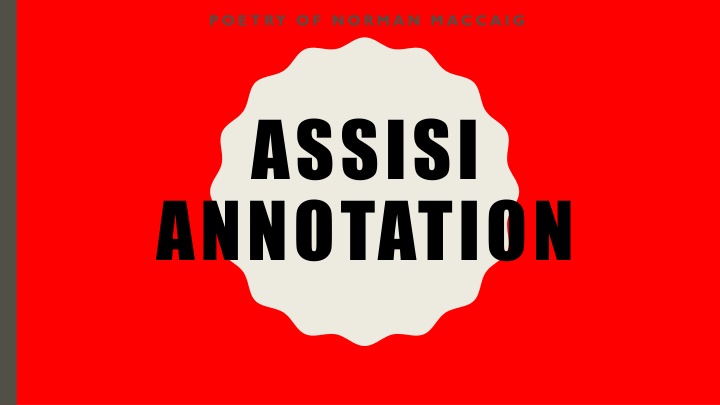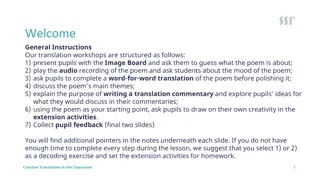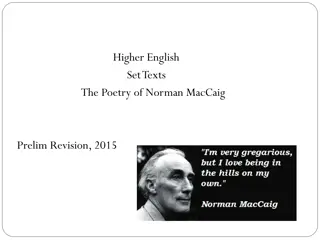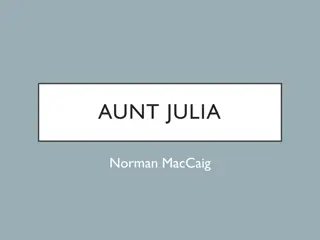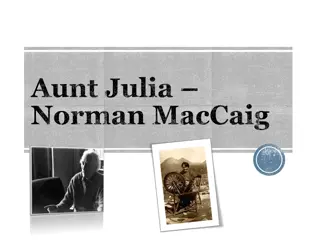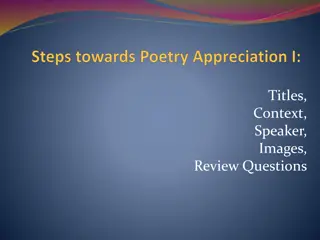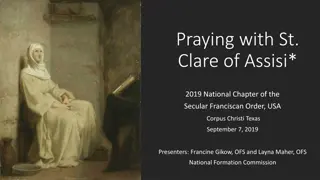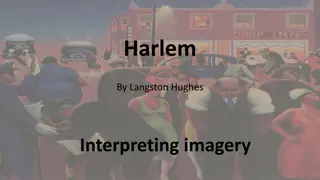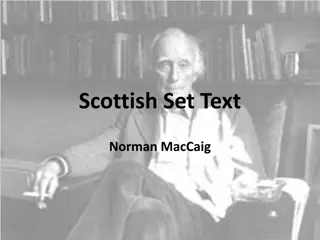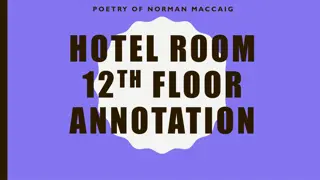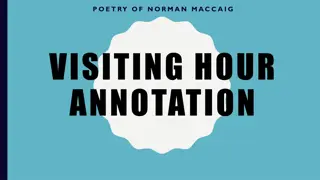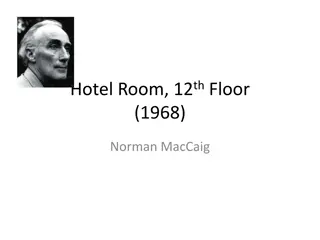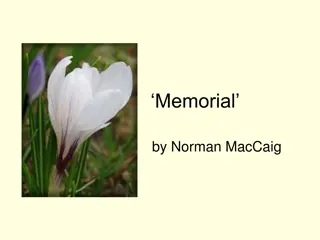Analysis of Norman MacCaig's Poem "Assisi
The poem "Assisi" by Norman MacCaig portrays the encounter of the poet with a beggar outside the Basilica of St. Francis of Assisi. MacCaig reflects on the hypocrisy of the church, criticizing its ignorance towards the poor while celebrating the compassionate life of St. Francis. Through vivid imagery and a critical tone, MacCaig explores themes of societal judgment, human nature, and the suffering of marginalized individuals, highlighting the disconnect between appearances and true compassion.
Download Presentation

Please find below an Image/Link to download the presentation.
The content on the website is provided AS IS for your information and personal use only. It may not be sold, licensed, or shared on other websites without obtaining consent from the author.If you encounter any issues during the download, it is possible that the publisher has removed the file from their server.
You are allowed to download the files provided on this website for personal or commercial use, subject to the condition that they are used lawfully. All files are the property of their respective owners.
The content on the website is provided AS IS for your information and personal use only. It may not be sold, licensed, or shared on other websites without obtaining consent from the author.
E N D
Presentation Transcript
POETRY OF NORMAN MACCAIG ASSISI ANNOTATION
Poets Main Idea This poem is an encounter MacCaig has with a beggar outside the Basilica of St. Francis of Assisi This is a famous landmark build to commemorate the life of St. Francis of Assisi a saint famous for his compassion and kindness to the poor. MacCaig is angry and frustrated at the hypocrisy of the church; they ignore a beggar while celebrating the life of a man who would have cared for him.
Reflective Nature of the Poem In the interview A Metaphorical Way of Seeing Things , MacCaig maintained that poetry is a psychological Optrex, it clears your eyes and you see things . MacCaig reflects throughout the poem on the hypocrisy of the church and his angry and bitter tone is apparent throughout the poem.
Theme Attack on the hypocrisy of the church and, in turn, human nature. We judge people by how they look and do not care for those outside of society in the way that we should. He also focusses on the suffering of the beggar and the fact that the tourists (and society in general) ignore this suffering in order to live their lives.
Structure Stanza One Description of the dwarf Stanza Two Focus on the priest and the church Stanza Three Focus on the tourists and ends with another description of the beggar
Stanza One The dwarf with his hands on backwards sat, slumped like a half-filled sack on tiny twisted legs from which sawdust might run, outside the three tiers of churches built in honour of St Francis, brother of the poor, talker with birds, over whom he had the advantage of not being dead yet. Think about: - What happens in this stanza? Is there a point where the stanza changes? - What is your impression of the beggar? - What mood or emotion is the poet feeling?
Stanza One Focus of stanza one Derogatory comment at start of poem Beggar is twisted and deformed. Outwardly ugly The dwarf with his hands on backwards sat, slumped like a half-filled sack Simile Shapeless and unattractive Shell of a human being Word Choice Slumped no energy/almost lifeless Alliteration ( s ) Emphasises how deflated he is
Stanza One Unable to stand on his legs. Cannot support him on tiny twisted legs from which sawdust might run, Alliteration Uncomfortable to say suggests dwarf is uncomfortable Reinforces sack imagery weak and lifeless
Stanza One Word Choice Beggar is outside church but also society Ostentatious nature of the church. Grand and impressive outside the three tiers of churches built in honour of St Francis, brother of the poor, talker with birds, Description of what St Francis did. Contrast to way beggar is being treated now
Stanza One Bitter tone due to the disconnect between St Francis and the church. Beggar is not getting help that he should Only advantage that the beggar has as he is living a miserable life over whom he had the advantage of not being dead yet. Suggestion that the beggar may soon be dead. Creates more sympathy Suggestion that he will only find peace when he is dead
Stanza Two A priest explained how clever it was of Giotto to make his frescoes tell stories that would reveal to the illiterate the goodness of God and the suffering of His Son. I understood the explanation and the cleverness. Think about: - What is your impression of the priest? - What is the priest s opinion of the people he is talking to? - What mood or emotion is the poet feeling?
Stanza Two Showing off his cleverness not the word of God Admiring the artwork rather than the word of God A priest explained how clever it was of Giotto to make his frescoes tell stories that would reveal to the illiterate Disparaging Tone looking down on people he should be helping
Stanza Two Reminds the reader of what the priest should be focussing on. the goodness of God and the suffering of His Son. I understood the explanation and the cleverness. Ambiguous - The cleverness of Giotto - Or the cleverness of the priest at commercialising church Critical of patronising nature of the priest
Stanza Three A rush of tourists, clucking contentedly, fluttered after him as he scattered the grain of the Word. It was they who had passed the ruined temple outside, whose eyes wept pus, whose back was higher than his head, whose lopsided mouth said Grazie in a voice as sweet as a child's when she speaks to her mother or a bird's when it spoke to St Francis. Think about: - What is your impression of the tourists? - What is the tourists impression of the beggar? - What is the poet s opinion of the beggar?
Stanza Three Shows numbers and speed of tourists only there to see the sights Alliteration to mimic the sounds of the chickens Extended metaphor comparing the tourists to chickens A rush of tourists, clucking contentedly, fluttered after him as he scattered the grain of the Word. Paying attention to the tourists and not the beggar (As St Francis would have wanted) Lightweight and not thinking
Stanza Three Shows MacCaig sees himself as separate and different from the other tourists Ignore the beggar/message of St Francis of Assisi Juxtaposition of something beautiful with something wasted. It was they who had passed the ruined temple outside, whose eyes wept pus, whose back was higher than his head, whose lopsided mouth Repetition of outside again shows beggar is outside of society and emphasises the beggar outside the beautiful church Descriptive language which shows the beggar is outwardly revolting
Stanza Three Emphasises MacCaig s difference saying thank you because he helped him Simile shows his inner beauty he is as innocent and as beautiful as a child said Grazie in a voice as sweet as a child's when she speaks to her mother or a bird's when it spoke to St Francis. Reference to St Francis again shows innocence and purity of the beggar The spirit of St Francis lies within the beggar. Emphasises important of message of St Francis
An Overview of the Stanzas Poem of contrasts Stanza One Starts with description of beggar and moves on to reveal the message of St Francis. Reveals the suffering of the beggar Stanza Two Starts with description of the priests and moves on to show his anger at the hypocrisy of the church Stanza Three Starts with description of the tourists and their unthinking approach to the church and beggar. Shows the inner beauty of the beggar and the importance of the true message of St Francis.
Revision Tasks To help you remember the key points of the poem you should: Write a summary of the poem showing how the poet moves from experience to reflection. Identify a key quote for each of the following points: The poet highlights the suffering of the beggar The poet reveals his anger and frustration at the priest The tourists mindlessly follow the priest The inner beauty of the beggar Write down and analyse any images used
